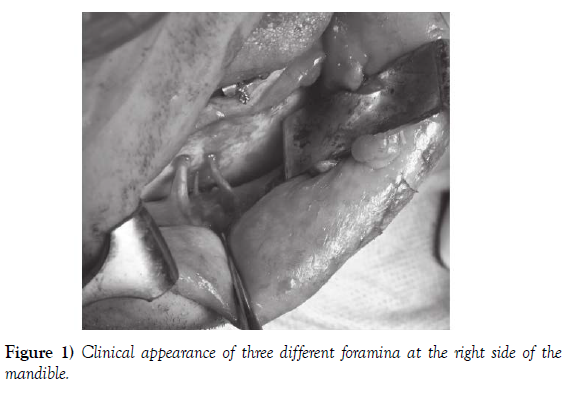A Case Report on Mental Foramen
Received: 03-Nov-2022, Manuscript No. ijav-22-5059; Editor assigned: 06-Nov-2022, Pre QC No. ijav-22-5059 (PQ); Accepted Date: Nov 23, 2022; Reviewed: 20-Nov-2022 QC No. ijav-22-5059; Revised: 23-Nov-2022, Manuscript No. ijav-22-5059 (R); Published: 30-Nov-2022, DOI: 10.37532/1308-4038.15(6).227
This open-access article is distributed under the terms of the Creative Commons Attribution Non-Commercial License (CC BY-NC) (http://creativecommons.org/licenses/by-nc/4.0/), which permits reuse, distribution and reproduction of the article, provided that the original work is properly cited and the reuse is restricted to noncommercial purposes. For commercial reuse, contact reprints@pulsus.com
Abstract
A review of the literature, was performed which disclosed no previous clinical cases reported but an incidence of 1.2% of triple foramina after investigating dry skulls or radiographic. The discussion stresses the importance of adequate preoperative radiological examination in the clinical situation especially when closed surgery is planned.
Keywords
Sensation; Mental foramen; Mental nerve
Introduction
The mental nerves, is primarily a sensory nerve and innervate after leaving the foramen the lower CA nines and premolars and therefore play an important role in procedures in this area such as administration of local anesthesia and surgical intervention. The absence and variation of accessory mental foramina has been reported in dry human mandibles and on radiographs previously, and can range from (0.2%) to (10.6%) on one side [1-3]. A double mental foramen appears in approximately 1% on the left side in Egyptian and Polynesian populations and in 1.1% on the right side of a Melanesian group.
CASE REPORT
A 28-year-old male was involved in a road accident resulting in bilateral condylar neck fractures of the mandible and an oblique fracture at the region of first molar on the right hand side. Under general anesthesia arch bars were applied in the maxilla and mandible followed by inter maxilla mandibular fixation (MMF) in order to achieve a correct occlusion. A vestibular incision was then placed from the lower central incisor to the area distal of the first molar on the right hand side. The immediate postoperative course and the primary healing were uneventful. The patient was reviewed with regard to fracture stability, occlusion and any other possible complications such as sensory or motor disturbance but was without any complaints (Figure 1).
Discussion
After reviewing the literature to the best of our knowledge, this is the first clinical case documented and reported with a triple mental foramina discovered during surgical treatment of a mandible fracture [4]. While treating a mandibular fracture with open reduction and ostheo synthesis we expected to and one but found three foramina. We considered only two to be of significance due to the small diameter of the third nerve but took care not to damage any of the nerves.
Postoperatively reviewing the preoperative computed tomography the first foramen was clearly depicted distally of the only existing premolar and the second foramen positioned apical of the mesial root of first molar. Finally the third minor foramen was observed in between the two. On the postoperative panoramic x-ray only two foramina could be detected. This confirms CT as is already well established, to be the method of choice, to investigate and describe anatomy. This is partly due to that CT has a low average distortion of 1.8%, compared to panoramic which has 23.5% and periapical radiographs 14% which is essential to be aware of when identifying delicate anatomical structures [5]. The awareness of the possibility of the existence of anatomical variations in this region which is evident from reviewing the literature makes it essential to have access to preoperative high quality radiology and good ability to interpret the x-ray while planning surgery.
Conclusion
It is essential to be aware of the possibility of these anatomical variations already when planning surgery and when viewing the pre-operative radiological examination. Thus we consider that it is important to report on the risk of anatomical variation of mental foramina, in order to avoid nerve damage in connection with surgical procedures.
Conflicts of Interest
None.
REFERENCES
- Agthong S, Huanmanop T, Chentanez V. Anatomical variation of the supraorbital, infraorbital, and mental foramina related to gender and side. J Oral Maxillofac Surg. 2005; 63(6):800-804.
- Katakami K, Mishima A, Shiozaki K, Shimoda S, et al. Characteristics of accessory mental foramina observed on limited cone-beam computed tomography images. J Endod. 2008; 34(12):1441-1445.
- Naitoh M, Hiraiwa Y, Aimiya H, Gotoh K, et al. Accessory mental foramen assessment using cone-beam computed tomography. Oral Surg Oral Med Oral Pathol Oral Radiol Endod. 2009; 107(2):289-294.
- Sonick M, Abrahams J, Faiella RA. A comparison of the accuracy of periapical, panoramic, and computerized tomographic radiographs in locating the mandibular canal. Int J Oral Maxil-lofac Implants. 1994; 9:455-468.
- Kay LW. Some anthropologic investigations of interest to oral surgeons. Int J Oral Surg. 1974; 3(6):363-79.
Indexed at, Google Scholar, Crossref
Indexed at, Google Scholar, Crossref







